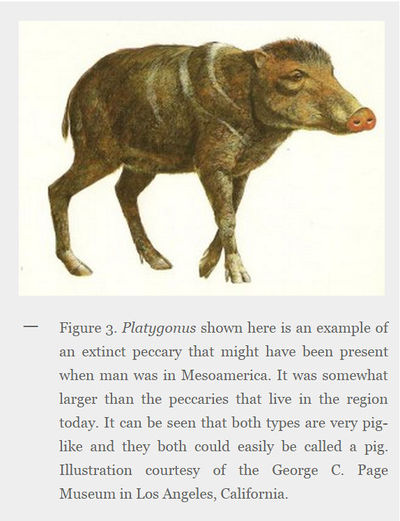
FAIR is a non-profit organization dedicated to providing well-documented answers to criticisms of the doctrine, practice, and history of The Church of Jesus Christ of Latter-day Saints.
(Redirected from Category:Swine in the Book of Mormon)
Wade E. Miller and Matthew Roper: [1]
Presently two distinct species of peccary live in Mesoamerica. These include the Collared Peccary (Pecari tajacu) and the White-lipped Peccary (Tayassu pecari), both of which can be found in the tropical regions near the Tuxtlas Mountains of the Yucatan. [2] The Jaredites as they presumably established settlements in Mesoamerica no doubt would have encountered them. They were hunted and eaten as early as Olmec times. Remains of these animals have been found associated with man for several thousands of years. There is a paleo-Indian carving of an extinct camel sacrum in the shape of a peccary. A Picture of this bone is shown by Evans. [3] The bone of this extinct camel came from deposits in central Mexico, and shows ancient interaction between this extinct animal and Pre-columbian natives. Remains of Pre-Columbian peccary have been found finds in Loltún Cave in the Yucatan [4] and in several other caves in the region associated with human artifacts. [5] There is no question that peccaries (“wild pigs”) and man shared this area since prehistoric times.

John L. Sorenson:
A good example of the confusion is with the coatimundi (Nasua narica). Landa, the padre who favored us with a detailed description of Yucatan, wrote of the beast, "There is an animal which they call chic, wonderfully active, as large as a small dog, with a snout like a sucking pig. The Indian women raise them, and they leave nothing which they do not root over and turn upside down"...Another name, from the Aztecs, is pisote (Nahuatl pezotli), which means basically glutton. Yet pisote is sometimes applied also to the peccary or wild pig. In regard to the peccary, the Nahuatl terms quauhcoyametl and quahpizotl were developed after the conquest to distinguish the native species from the introduced Castilian pig, so by extension, the coati was sometimes termed quauhpezotli, tree-glutton, to distinguish it from the peccary, the ground-glutton.[6]
John L. Sorenson:
A good example of the confusion is with the coatimundi (Nasua narica). Landa, the padre who favored us with a detailed description of Yucatan, wrote of the beast, “There is an animal which they call chic, wonderfully active, as large as a small dog, with a snout like a sucking pig. The Indian women raise them, and they leave nothing which they do not root over and turn upside down; and it is an incredible thing how wonderfully fond they are of playing with the Indian women, and how they clean them from lice.†The flesh of the coati was also widely eaten, and the animal remains a pet today in some rural Mexican homes. . . . What ought the coati to be called in English? One common Spanish name is tejon. Unfortunately, tejon is also the Spanish name for badger as well as raccoon. Another name, from the Aztecs, is pisote (Nahuatl pezotli), which means basically glutton. Yet pisote is sometimes applied also to the peccary or wild pig. In regard to the peccary, the Nahuatl terms quauhcoyametl and quahpizotl were developed after the conquest to distinguish the native species from the introduced Castilian pig, so by extension the coati was sometimes termed quauhpezotli, tree-glutton, to distinguish it from the peccary, the ground-glutton. Finally, the Mayan languages labeled the coati for its playful aspect, hence chic, clown.[7]
The following 3 pages are in this category, out of 3 total.

FAIR is a non-profit organization dedicated to providing well-documented answers to criticisms of the doctrine, practice, and history of The Church of Jesus Christ of Latter-day Saints.
We are a volunteer organization. We invite you to give back.
Donate Now